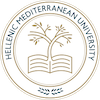Funding
1) Polymer Nanocomposites for Electromagnetic Shielding applications (PolyShield), Operational Program Competitiveness, Entrepreneurship and Innovation, under the call RESEARCH – CREATE – INNOVATE (project code: T1EDK-02784), 2018-2021
The project concerns innovative polymer nanocomposites offering electromagnetic shielding. The scope is the design and development of the appropriate primary nanocomposite materials that can be employed by a participating enterprise for the development of innovative meshes, fibers and fabrics suitable for electromagnetic shielding in constructions, new electronic devices and personal protection. For the implementation of the project, innovative approaches have been chosen, which can lead in the development of significant technology that can be directly exploited. In this context, particular emphasis will be given on the:
- Investigation of the requirements for the use of nanofillers, such as carbon allotropes (graphene and carbon nanotubes), metal oxide nanostructures, metal nanoparticles and fibers etc. in electromagnetic shielding applications
- Development of these nanofillers with low-cost and environment-friendly techniques, allowing a controlled modification of their properties, easily applicable to a production line
- Investigation of approaches for incorporating the nanofillers into polymer matrices so that the final nanocomposites, in the form of controlled-geometry fibers and grids, possess EM shielding properties at microwaves
- Understanding of the electromagnetic shielding mechanisms of the studied polymer nanocomposites and finding the nanofiller offering optimal electromagnetic shielding.
- Field evaluation of industrial nanocomposite prototypes, developed in the infrastructures of THRACE NG, employing a suitable pilot closet for outdoor use.
The deliverables will be laboratory and industrial prototypes as well as significant scientific information
2) Nanostructured composite paints for electronics electromagnetic shielding, SPS NATO project (project code: G5477), 2018-2021
The aim of this project is to develop effective nanostructured composite polymer paints for electromagnetic shielding, in order to ensure compatibility and to reduce visibility of electronic equipment. Graphene, carbon nanotubes and other nanomaterials based on metal oxides within various polymer matrices will be tested for such paints in order to ensure an average shielding efficiency of -30 up to -60 dB in the wide frequency range from 30 MHz to 30 GHz. End-users of such paints could be producers of thermal imagers and optical sights, devices for radiation control, Unmanned Aerial Vehicles and other special electronic equipment.
3) Sustainable food packaging based on polymers incorporating essential oils, Greek Operational Program Competitiveness, Entrepreneurship and Innovation, under the call , 2019-2021
The project concerns the study and development of innovative antimicrobial and antioxidant packaging membranes (both edible and non-edible), using natural bioactive substances, as well as their application to packaging of cheese and sausages, which can be subjected to significant microbial lesions and oxidation of fat, color and aroma, so that these can be kept safer with improved quality characteristics and increased lifetime. In this context, micro- and nanoparticles of essential oils based on oregano, rosemary and thyme and/or natural olive-oil antioxidants will be produced, in order to be used as additives or coatings in typical polymeric food packaging already employed in the market, such as polylactic acid (PLA), as well as in edible films such as those from chitosan or whey proteins. The films will then be tested in cheese and sausage packaging in order to determine which of those can introduce better antimicrobial stability, can provide effective protection against oxidative decay and if they can replace those already used in the market. Therefore, the final laboratory scale membranes could lead to innovative materials for flexible food packaging with anti-microbial acti
4) Innovative materials for nets for fish farms with environmentally friendly anti-fouling action, Greek Operational Program Maritime and Fishery, 2019-2022
The project concerns the design and the development of innovative materials with anti-fouling properties, based on a combination of photocatalytic, self-cleaning and biocide action, to be employed as nets for aquaculture applications. Two approaches will be considered:
(a) Polymer nanocomposites, emphasis given on HDPE with metal oxides nanoparticles (such as TiO2, ZnO, etc.), developed employing thermal extrusion. Initially, yarns will be developed and their anti-fouling action will be examined in petri dish with small algae. In addition, their toxicity will be tested by studing the transfer of metal oxides to mussels or small fishes. Then, small nets will be developed in order to investigate their anti-fouling action in real aquaculture conditions, as well as their mechanical behavior. In the final phase of the project, the applicability of the developed materials in a production line and in the market will be investigated.
(b) Polymeric coatings based on biocidal polymers. Initially, copolymers will be synthesized and chemically modified, while in the final phase, these copolymers will be coated on aquaculture nets. The functionality of the coatings in terms of anti-fouling action and toxicity will be tested in the laboratory and in real aquaculture conditions, while their mechanical behavior will be also investigated. In the final phase of the project, the applicability of the developed materials in a production line and in the market will be investigated.
(5) New germicide nanocomposites for biological protection and decontamination, SPS Project G5868 https://spsg5868.wordpress.com/#
The project deals with the development of smart patches with effective germicidal activity as well as suitable physical and chemical properties for special filters and special clothing. These new patches will be made of new hybrid materials based on doped TiO2/graphene reinforced in polymer fibres that will target the synergistic combination of photocatalysis on TiO2 and electromechanical action of graphene as germicidal agent to obtain enhanced germicide activity materials. The development and study of novel nanocomposite materials exhibiting effective germicidal action, for use in the prevention of healthcare associated bacterial and viral infections and in biological defense (CBRN) is an our time priority.
The project outcomes concerns novel nanocomposite materials exhibiting effective germicidal action, for use in the prevention of healthcare associated bacterial and viral infections and in biological defense (CBRN).

